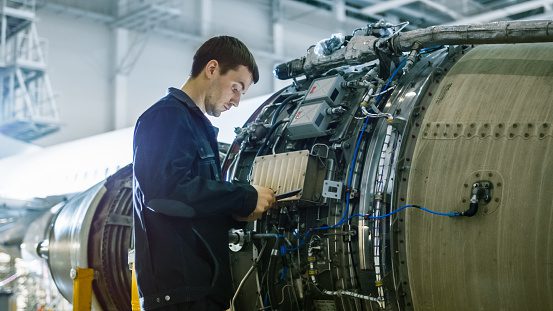| Aerospace Engineer Key Stats | |
|---|---|
| Avg. Salary / year | $141,180 |
| Avg. Pay / hour | $67.88 |
| Education | 4+ Years |
| Job Outlook | 2% |
| Total Employed | 68,440 |
An Aerospace Engineer uses the concepts of air and its interactions with moving objects to design and improve aircraft.
Aerospace Engineers may work for the federal government assisting and improving national security or also work for commercial aircraft to improve fuel efficiency and noise pollution.
This career will be perfect for someone looking for a challenging, well-paying career.
In addition, individuals joining this field can take pride in securing our national defense by improving aircraft for our safety or improving aircraft fuel efficiency to lower our reliance on oil.
Go to Page Section:
Education Requirements to Become an Aerospace Engineer
Individuals who want to become an Aerospace Engineer may seek entry level positions in this field with a bachelor’s degree in Aerospace Engineering.
They can also enter this field by focusing on a different engineering field or a related aerospace systems scientific field.
While pursuing their aerospace undergraduate degree, an individual will take many specialized courses such as general engineering principles, structures, stability and control, propulsion, mechanics and aerodynamics.
Students will learn these topics in a laboratory or a classroom setting.
In addition, individuals may seek a university or college that offers a cooperative program.
In this type of program, a student will gain practical experience after being partnered with a potential employer.
This experience can be extremely valuable and may help an individual become employed soon after attaining their degree because of the job experience gained during the program.
Some other types of programs that a university or college may offer is a 5 year program that results in a bachelor’s and master’s degree in engineering.
Individuals should ask their university or college for more information regarding the cooperative and 5 year programs or if not already enrolled in school, search for schools with those types of programs.
An Aerospace Engineer doesn’t necessarily need to be licensed for entry level positions, but may look into this option if interested in pursuing career advancement or managerial positions.
An individual can visit the National Council of Examiners for Engineering and Surveying to learn more information regarding licensing for engineers.
Individuals seeking a position with the Federal government must also pass a security clearance and in addition, must also be a citizen of the U.S.
These requirements are necessary because of the sensitivity revolving national security.
Aerospace Engineer Job Description
Using the concepts of Aerodynamics, an Aerospace Engineer will design, develop, prototype, test and manufacture a variety of aircraft.
Aircraft may include spacecraft, satellites, missiles, rockets, and a variety of other flying mechanisms.
After receiving a request to develop an aircraft, an Aerospace Engineer will determine whether the proposal is a financially and technically feasible project to take on.
If the proposal is determined to be feasible, an Engineer will then develop and coordinate the design, production and testing of an aircraft or aerospace invention.
In creating aviation devices, an Aerospace Engineer may create and design new technologies in aviation, spacecraft and defenses systems.
Projects an individual is working on must meet quality standards.
Aerospace Engineers will inspect any products that do not meet quality standards and are malfunctioning or damaged.
They must then identify the problems and plan and create a solution to repair any damages or malfunctioning products.
Aerospace Engineer Salary and Career Path
In 2012, the median annual wage for Aerospace Engineers was approximately $103,720.
The exact salary will depend on the industry a professional works in.
For example Aerospace Engineers working in the Federal government can earn a median annual wage of approximately $110,860 while individuals working Aerospace product and parts manufacturing can expect to earn approximately $97,560 per year.
Furthermore, individuals at the entry level can expect to earn $71,859 per year.
Individuals can expect a 7 percent increase in job creation through the year 2022.
The job prospects are considered slower than average when compared to other professions and industries.
However, the actual job prospects will depend on the industry an individual is seeking work in.
For example, there will be a demand for this profession in the federal government due to national security as well as in research in development to create fuel efficient and reduce noise pollution.
Individuals will have better prospects in either of these two industries.
Individuals who are looking for a challenging and well paid profession in engineering will be impressed by the Aerospace Engineering career.
This position can not only work with improving airspace aircraft, it can also be heavily invested in our national security.
In addition, individuals who want to become an Aerospace Engineer can expect to enter this field at entry level with a minimum of a bachelor’s degree in Aerospace Engineering.
![]() The below information is based on the 2024 BLS national averages.
The below information is based on the 2024 BLS national averages.
National Average Salary
$141,180Average Salary by State
| State | Avg. Annual Salary |
|---|---|
| Alabama | $136,210 |
| Alaska | $114,120 |
| Arizona | $143,930 |
| Arkansas | $101,650 |
| California | $157,060 |
| Connecticut | $125,700 |
| District of Columbia | $160,830 |
| Florida | $128,500 |
| Georgia | $151,320 |
| Hawaii | $153,730 |
| Idaho | $95,340 |
| Illinois | $145,720 |
| Indiana | $112,860 |
| Iowa | $137,430 |
| Kansas | $118,870 |
| Kentucky | $127,580 |
| Louisiana | $127,100 |
| Maine | $137,110 |
| Maryland | $158,290 |
| Massachusetts | $148,270 |
| Michigan | $122,710 |
| Minnesota | $141,910 |
| Mississippi | $108,240 |
| Missouri | $116,350 |
| Nevada | $118,280 |
| New Jersey | $142,110 |
| New Mexico | $141,350 |
| New York | $131,040 |
| North Carolina | $120,550 |
| Ohio | $134,650 |
| Oklahoma | $113,010 |
| Oregon | $120,210 |
| Pennsylvania | $120,670 |
| South Carolina | $137,870 |
| Tennessee | $120,900 |
| Texas | $130,320 |
| Utah | $128,730 |
| Vermont | $138,860 |
| Virginia | $143,050 |
| Washington | $159,790 |
| Wisconsin | $98,540 |
The highest-paying state in this field is District of Columbia, with an average salary of $160,830.
Here are the five states with the highest salaries in the field:
* Employment conditions in your area may vary.
Frequently Asked Questions
What is an aerospace engineer?
Aerospace Engineers design mostly aircraft, spacecraft, satellites, and missiles.
Their job responsibilities also include testing prototypes.
Aerospace engineers typically specialize in one of the following types of engineering: aeronautical or astronautical.
Aeronautical engineers design and study aircraft, while astronautical engineers study the science and technology of spacecraft.
Aerospace engineers can specialize even further in various subspecialties, such as airplanes and helicopters, remotely piloted aircraft, spacecraft, and military missiles and rockets.
An aerospace engineer needs analytical, math and problem-solving skills, but also critical-thinking skills and business skills.
Aerospace engineers also need good writing skills in order to document and explain their designs.
How much does an aerospace engineer make?
According to the Bureau of Labor Statistics, the median annual wage for aerospace engineers was $115,220 in May 2018.
The salary depends on the industry where they work.
Aerospace engineers who work in the research and development field earned a median annual wage of $124,430 while those who work in engineering services earned $110,200 a year, as of May 2018.
How much does it cost to become an aerospace engineer?
Aerospace engineers must hold a bachelor’s degree in aerospace engineering or a related engineering or science field.
Bachelor’s degree programs typically combine classroom, laboratory and field studies and cover topics such as general engineering principles, propulsion, mechanics and aerodynamics.
A bachelor’s degree program can cost you anywhere between $30,000 and $70,000 a year.
The United States Air Force Army offers a bachelor program at $0 a year.
What is the demand for aerospace engineers?
According to the Bureau of Labor Statistics, employment for aerospace engineers is projected to grow 2 percent from 2018 to 2028.
The competition in this field is expected to be strong; candidates who know software programming and have experience in stress and structural engineering should have the best job prospects.
How long does it take to become an aerospace engineer?
Training for a career in engineering often starts in high school.
Students who want to study engineering in college should take math, science and computer programming classes in high school.
Bachelor’s degree programs usually last four years.
Some colleges and universities also offer five-year programs that lead to a bachelor’s degree and a master’s degree after graduation.
ABET is the accrediting institution for programs in engineering.
If you want to work in research you should also consider getting a graduate degree.
Ph.D. programs in aerospace engineering are available and can be completed in 3-5 years.
Getting a state-license is not a requirement but can give you more independence and better job prospects.
Becoming a fully licensed engineer will usually require at least years of work experience.














